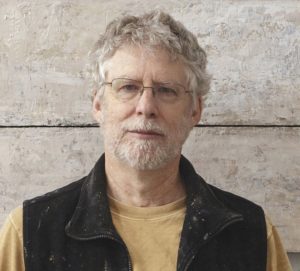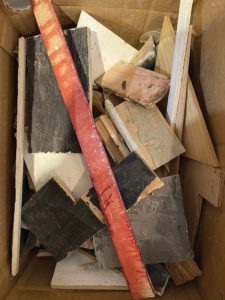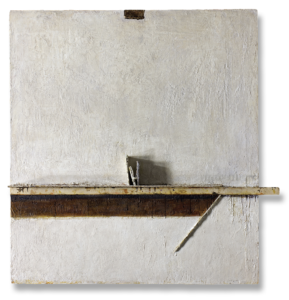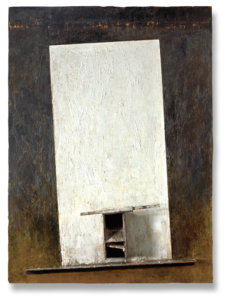An Artist’s Journey: Between Known and Unknown Worlds

Brian Dickerson’s artwork is about the great mysteries. Throughout his life and professional career, he has always been drawn to the edges, the intersections, and the boundaries of things. He is organically attracted to the shadows, reflections, and other ambiguities that animate the spaces between one dimension and the next, one reality and another, between known and unknown worlds.
His latest work, a collection of ten pieces, reflects the artist’s exceptional ability to transform the simplest forms and shapes into beckoning portals, openings, and horizons that promise something more, perhaps. Dickerson’s work suggests the exaltation of emotion at the edge of knowledge. His goal is to encourage the viewer to approach the threshold of knowledge—the place he described in one interview as the “cairn space”—and there, his job ends. What, if anything, exists beyond that is completely up to the viewer.
Strongly anti-theistic in his personal beliefs, Brian described how he works to clear his mind of such things when working, becoming absorbed, instead, with the materials. “I never know what it’s about until later when I sit back and study it for a while,” he said. “Sometimes that takes several weeks, months, or years. I can appreciate the various things that people project onto my work. I get the symbolism—and the emotional energy that symbols can stir up—but how that emotional energy gets directed is up to the individual.”

Boxes filled with discarded wood. Dickerson refers to these boxes as types of reliquaries.
He readily admits to all the influences of his culture, family, and experiences in the world. Although he left the small Dutch Reformed Church of his childhood long ago, he’s fully aware of how the forms and shapes of Christianity got inside him and influenced him.
When I asked about his childhood, he described growing up in rural Middleburgh, New York in the 1950s and 60s. His parents were both teachers, and his father directed the music program for the K-12th grade central school he attended. The most significant—and traumatic—event in an otherwise stable and secure childhood was his older brother Noel’s death when Brian was six. Noel—thirteen, the oldest of four, the star of the family—drowned in a nearby creek.
“I remember feeling his absence and following the emotional cues of the adults around me, but I didn’t know anything about grieving or loss,” he said. “My brother was gone and wasn’t coming back. I was provided with those hard facts. Of course, I wondered where he went. I wondered about it a lot. I’m still wondering about it.”
So what’s it all about?
Who were Dickerson’s early artistic influencers and mentors? When asked this question, Brian immediately told a story about going to the Philadelphia Art Museum with his good friend, the well-known watercolorist Philip Jamison. “We were rushing through one of the galleries,” Brian described the situation, “and Phil suddenly elbowed me, pointed to the altarpiece—The Crucifixion, with the Virgin and Saint John the Evangelist Mourning by Rogier van der Weyden—and told me that I should come back and look at it more closely sometime.
“When I eventually returned to spend some unfettered moments with the piece, I think that at least one of the things my friend wanted me to get from the exercise was more clarity about my artistic journey. I was still in my 20s at the time.
“Structurally, my work has some similarities to the van der Weyden altarpiece—certainly in terms of the constructed form, the cruciform and other shapes, and its purpose, as an altarpiece, in focusing a viewer’s attention. But there, the resemblance ends.
“In the altarpiece, the meaning is predetermined. The mystery is solved. There isn’t any room to imagine the content. There isn’t any space to ask questions and discover one’s own answers. I want my work to invite viewers into places they can’t physically enter, but beyond that invitation, each of us is on our own.”
The process
Dickerson has several boxes filled with discarded pieces of wood. He refers to these boxes as types of reliquaries, but unlike a container holding religious objects, the boxes contain parts of paintings—fragments from twenty to thirty years of work. Sometimes he will sit down and go through these boxes as a meditation. He says he usually does it when he is not looking for anything in particular and it is most enjoyable to explore these boxes without pretext, to see what jumps out.
“Several months ago, I was exploring my reliquary and pulled out four small pieces of wood,” he said. “I had some vague notion of starting a new piece and was looking for inspiration, perhaps. So I picked up four small pieces and put them aside on a small table next to my work chair. Here they sat for several weeks without another thought.”
Dickerson started the painting that would become Below and Above in the fall of 2021. It began as a simple painting. His initial intention was to minimize the structural elements. He first applied thin washes of umber—burnt and raw—followed by what the artist calls “white painting.”
“I don’t think about color when I’m painting with white,” he said. “There are many different whites involved.” Looking closely, the viewer can see how the paint is applied and layered to become many unnamed colors, an effect Dickerson refers to as “a sense of possibility.”

Below and Above (44 x 43 x 6½ inches, 2021–2022)
He then added a thin piece of wood that created the ledge. “The piece of wood I chose wasn’t long enough to go all the way across, so I added that other piece to the right and let it run off the edge a couple of inches,” he explained. “I like the tension created by an element running off the frame, pointing beyond itself.” Next, he incorporated the small dark piece of wood at the top, followed by the placement of a fragment of wood under the ledge on the diagonal. That’s the way it was for several weeks.
“Then one morning—I wasn’t thinking about it—I just picked up those small pieces of wood—the ones that I had fished out of a box several weeks before—and placed them on the ledge. I stepped back and immediately felt a sense of completion. So many things came together with the addition of these final elements.”
Dickerson said the title “Below and Above” came to him right away. “Up, down, above, below—it’s all about your orientation.” Depending on where one places oneself in the painting, the viewer could be either above, below, or both. If viewers orient themselves with the three small pieces of wood on the ledge, they are above what’s going on underneath, but also below the small central dark element at the top. “What one sees and experiences depends on where we place ourselves in the universe,” he said.
For Dickerson, all the basic shapes and forms he employs in his work—the ledge that creates a horizon, as well as a landscape, with the sky in one place and the earth in another—are human agreements, not absolutes. “We need agreements about what things mean to function as a human community,” he said, “but change is the only true constant.”

The seen and unseen (60 x 44 x 7 inches, 2020–2022)
The seen and unseen
All Dickerson’s paintings invite the viewer into the frame, encouraging the exploration of both possibilities and boundaries. In Dickerson’s worldview, this is an intensely personal and unique process. For him, the creative process is about continually facing whatever is unknown and unseen—that gap between experience and description—because that’s where the good stuff is. “It’s a special kind of knowledge, perhaps, that awareness of limitation, where knowledge ends,” Brian said one time when we were discussing Galotta, a painting he also completed this year.
“The small dark openings comprise the invitation, and I think the challenge is to stare into those empty, mysterious, and unknown spaces and enter them, openly and imaginatively, if we can. Maybe, with time, something takes shape and form—and becomes describable for the first time. This process is where all new things come from.”
